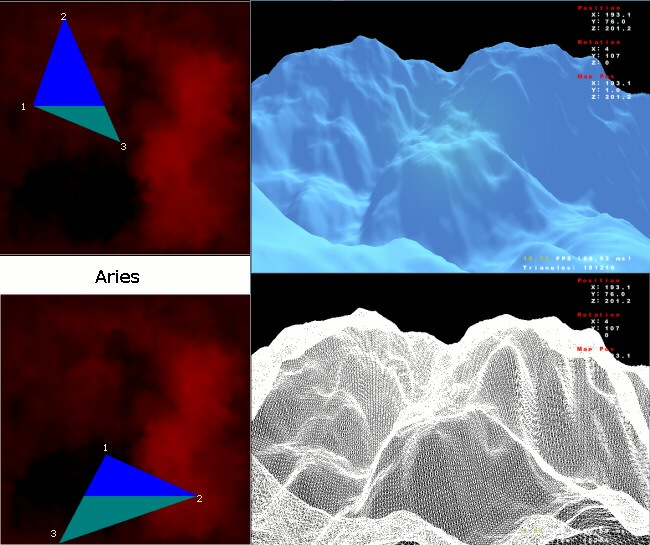 |

Submitted by , posted on 27 October 2000
|
 |

Image Description, by

This image is of an idea I had for terrain rendering using heightmaps. I'm not
sure if this is used already. I would hope it is because it is so simple and
works so fast. There is also limited overdraw (anything that is overdrawn
wouldn't be worth culling out) and it lends itself VERY well to seamless, non
popping LOD (I'll post separetly on this if anyone is interested). The image on
the left shows a view of the heightmap (512x512). You start with a point (your
current location #1) and then calculate points #2 and #3 based on HFOV and
viewing distance. These three points form a triangle of heights on the heightmap
to be rendered. Now for the easy part. Going through old programming books I
came across triangle scan conversion. I thought this would apply very well to
this situation. For you old school programmers, this is how you drew polygons to
the screen before OpenGL and hardware rasterizers. Divide the triangle into a
top and bottom triangle (green and blue - each has a perfectly horizontal side)
and scan convert each triangle. Thats it, you can adjust (I use sliders) your
viewing distance, HFOV, all kinds of stuff and watch it in action. It's kinda
neat.
I'm positive this is commonplace as it seems so natural and easy so this likely
won't impress anyone. The only downside is if you are high above the landscape
and look down you can see missing polygons. I've fixed this with using a
compensate factor which moves your location back and that reduces this problem.
If anyone is interested I can post another solution to this which shows off the
very fast and accurate LOD, as well as a permanent solution to the above problem
but it should be obvious extending what I've done here. The pics on the right
are images of the rendered landscape. The polygon count is pretty high and it
runs pretty well. I have a Celeron 300 and Geforce256. I can send a demo and put
up a page if anyone wants to try their fps on a faster and better machine.
Again, I appologize if this idea is old and lame and no one is impressed, I've
just never seen it done before. Seems to me a great way to speed up an engine
and a lot quicker and more accurate than quadtrees (and the such).
You can't read it in the pictures but its about 10 fps for 181,216 triangles. I
have also done zero optimizations so take that into consideration. I am wanting
to increase the map size, but just scaling everything up doesn't seem to work as
it looks the exact same. Any suggestions (the polygons are very small)?
Aries
|
|

